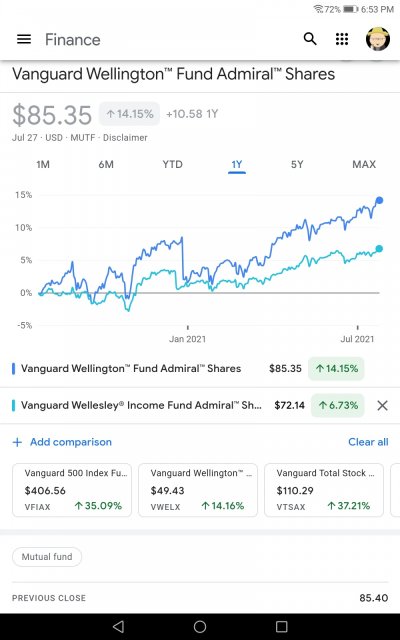MichealKnight
Full time employment: Posting here.
- Joined
- May 2, 2019
- Messages
- 520
Greetings and Salutations.....
I'm thinking of adding about $200k to stock/bond investments. This would still keep me under my desired allocation into stocks and bonds, I don't want to be over 60% ever, and if I add this $200k.... it would mean I'd be around 57%...with a vast majority of that being stocks.
I'd earmark this $200k for DD's college (well, 4 years worth anyway) which hopefully would begin 5 years from now. The goals, or hopes - in reality are:
1.)Obviously, don't lose money.
2.)At least, keep up with inflation - which means 3% average year returns
3.)If it did 5% nominal, average year - it would really be delicious.
Any thoughts? General or specific would be very appreciated.
I love that in previous crashes - this fund seemed to lose 10% when the S/P lost 20%. But with 60% bonds, I wonder that as rates rise in the next few years - -does that make VWINX a dud?
Hoping to park this 200k in 5 year "set it and forget it" mode.....perhaps in year 2 or year 3....take a bit off the table to hedge against any potential crash that might happen the night before tuition comes due.
Any opinions, suggestions, insults, all would be much appreciated. Thanks
I'm thinking of adding about $200k to stock/bond investments. This would still keep me under my desired allocation into stocks and bonds, I don't want to be over 60% ever, and if I add this $200k.... it would mean I'd be around 57%...with a vast majority of that being stocks.
I'd earmark this $200k for DD's college (well, 4 years worth anyway) which hopefully would begin 5 years from now. The goals, or hopes - in reality are:
1.)Obviously, don't lose money.
2.)At least, keep up with inflation - which means 3% average year returns
3.)If it did 5% nominal, average year - it would really be delicious.
Any thoughts? General or specific would be very appreciated.
I love that in previous crashes - this fund seemed to lose 10% when the S/P lost 20%. But with 60% bonds, I wonder that as rates rise in the next few years - -does that make VWINX a dud?
Hoping to park this 200k in 5 year "set it and forget it" mode.....perhaps in year 2 or year 3....take a bit off the table to hedge against any potential crash that might happen the night before tuition comes due.
Any opinions, suggestions, insults, all would be much appreciated. Thanks

